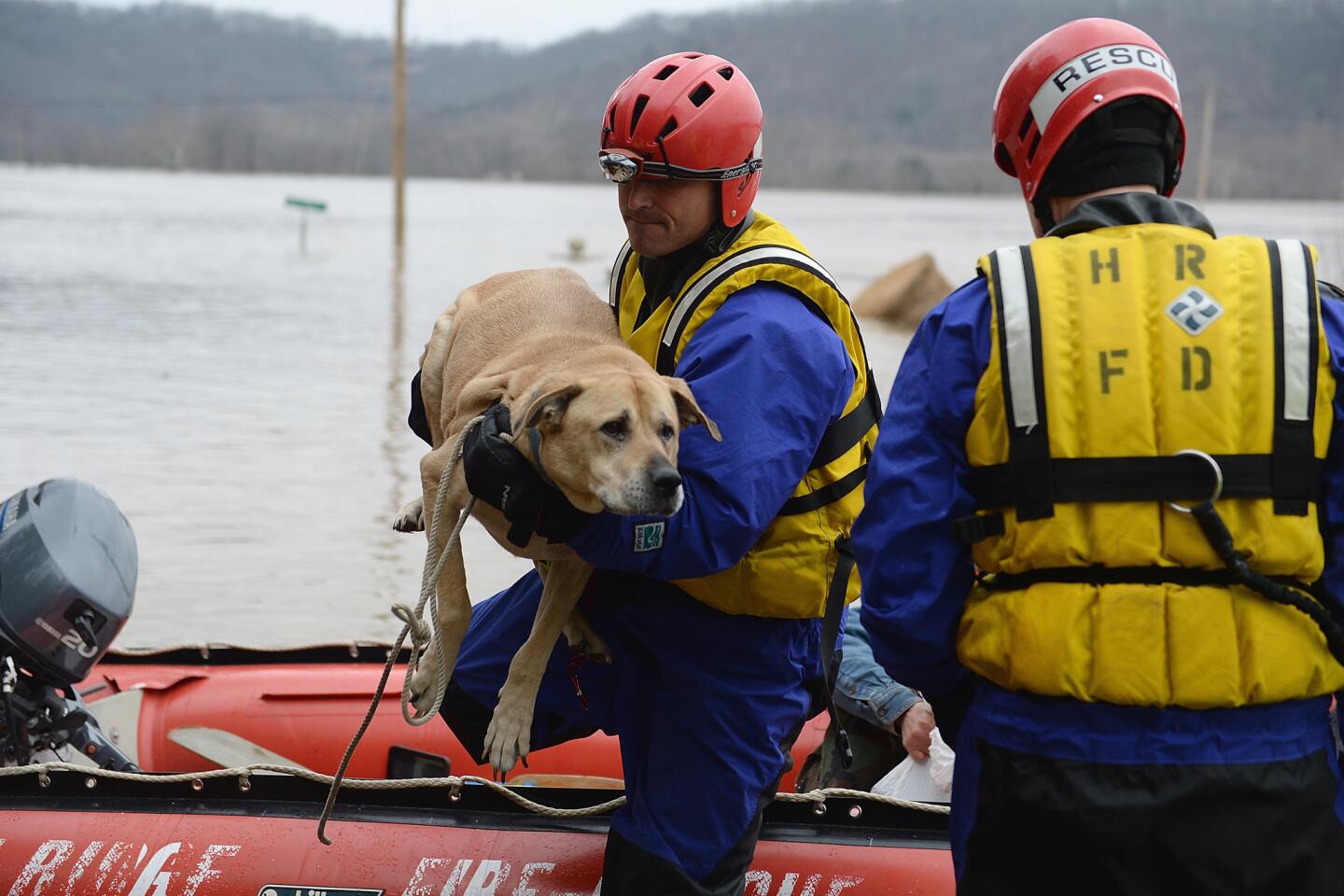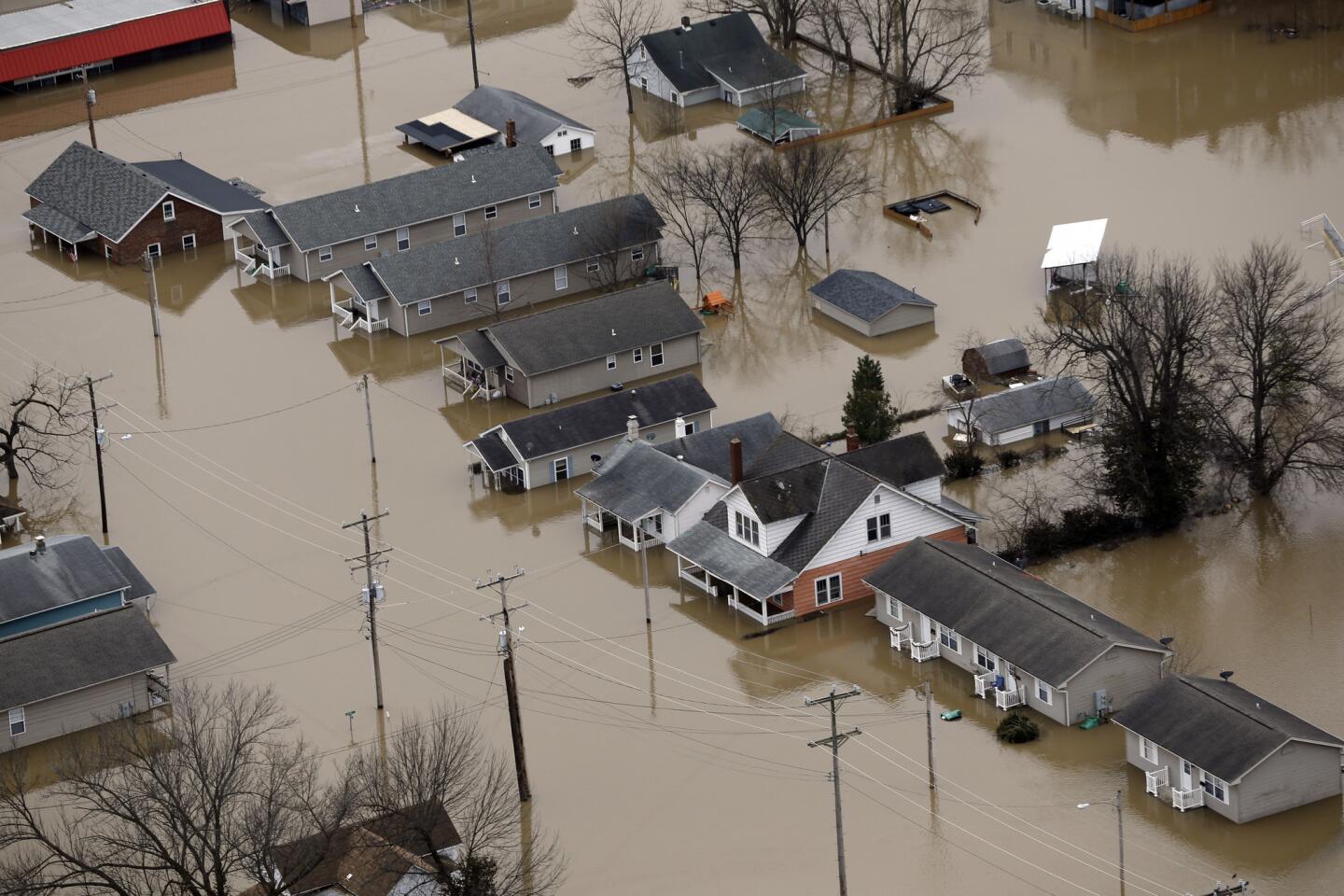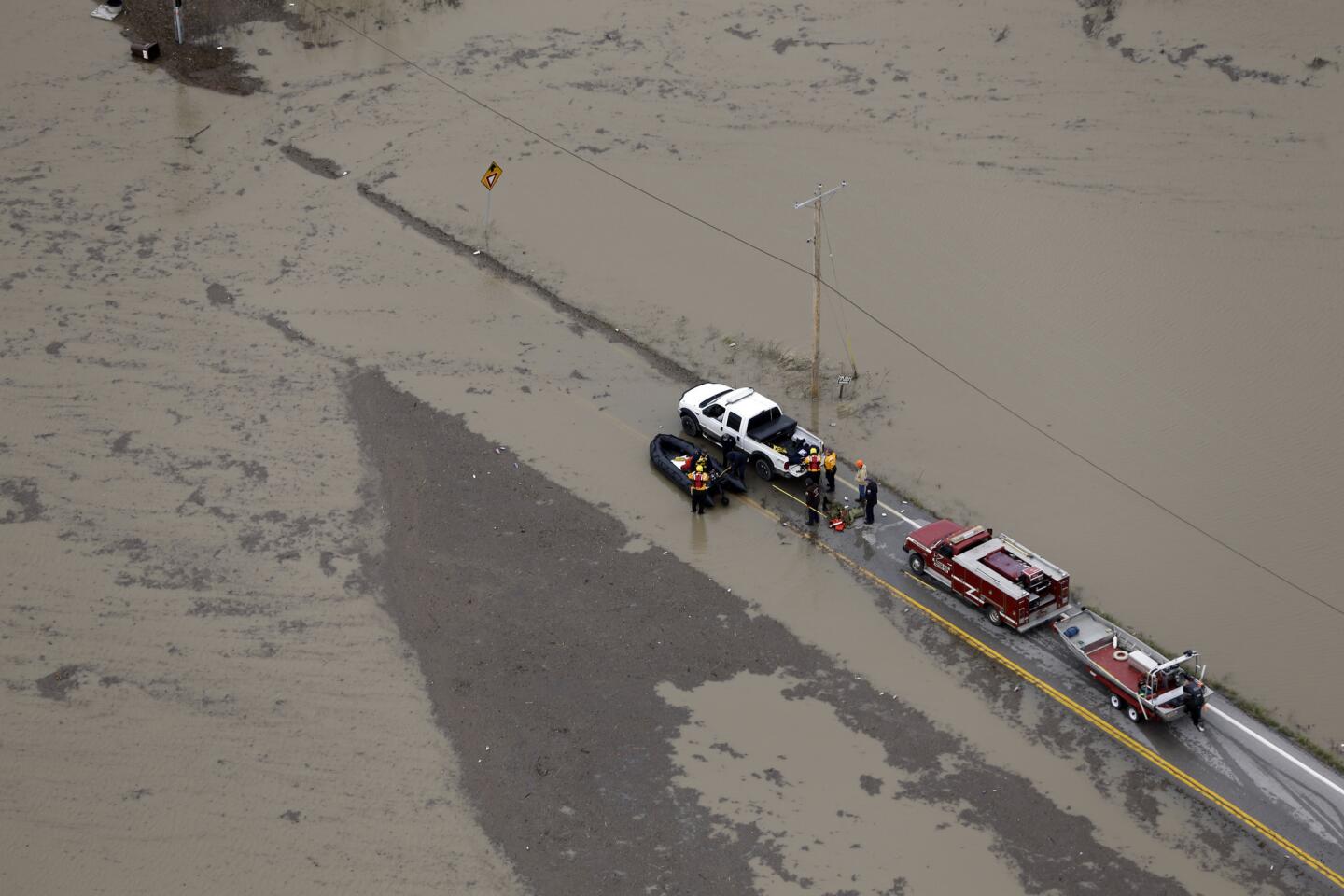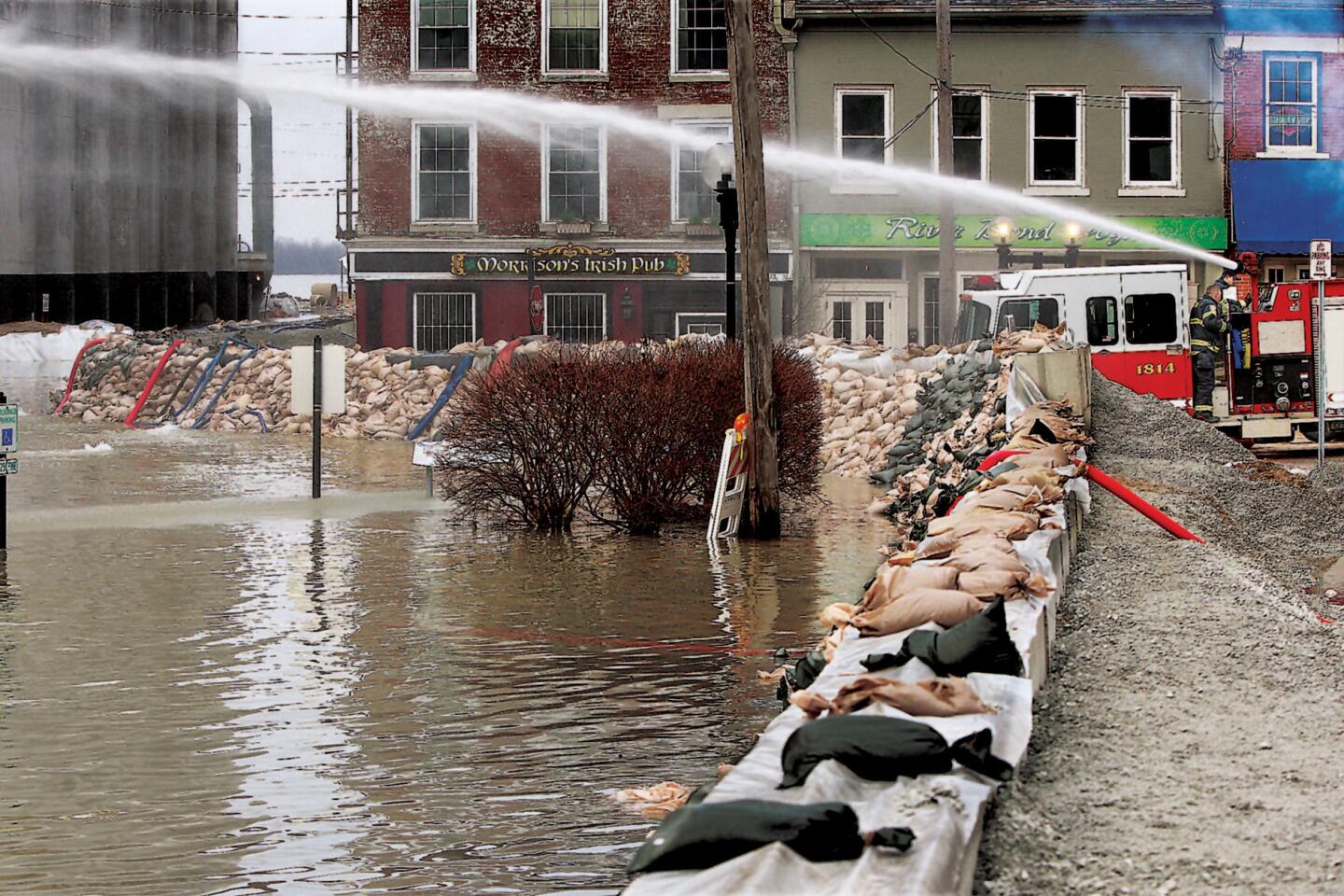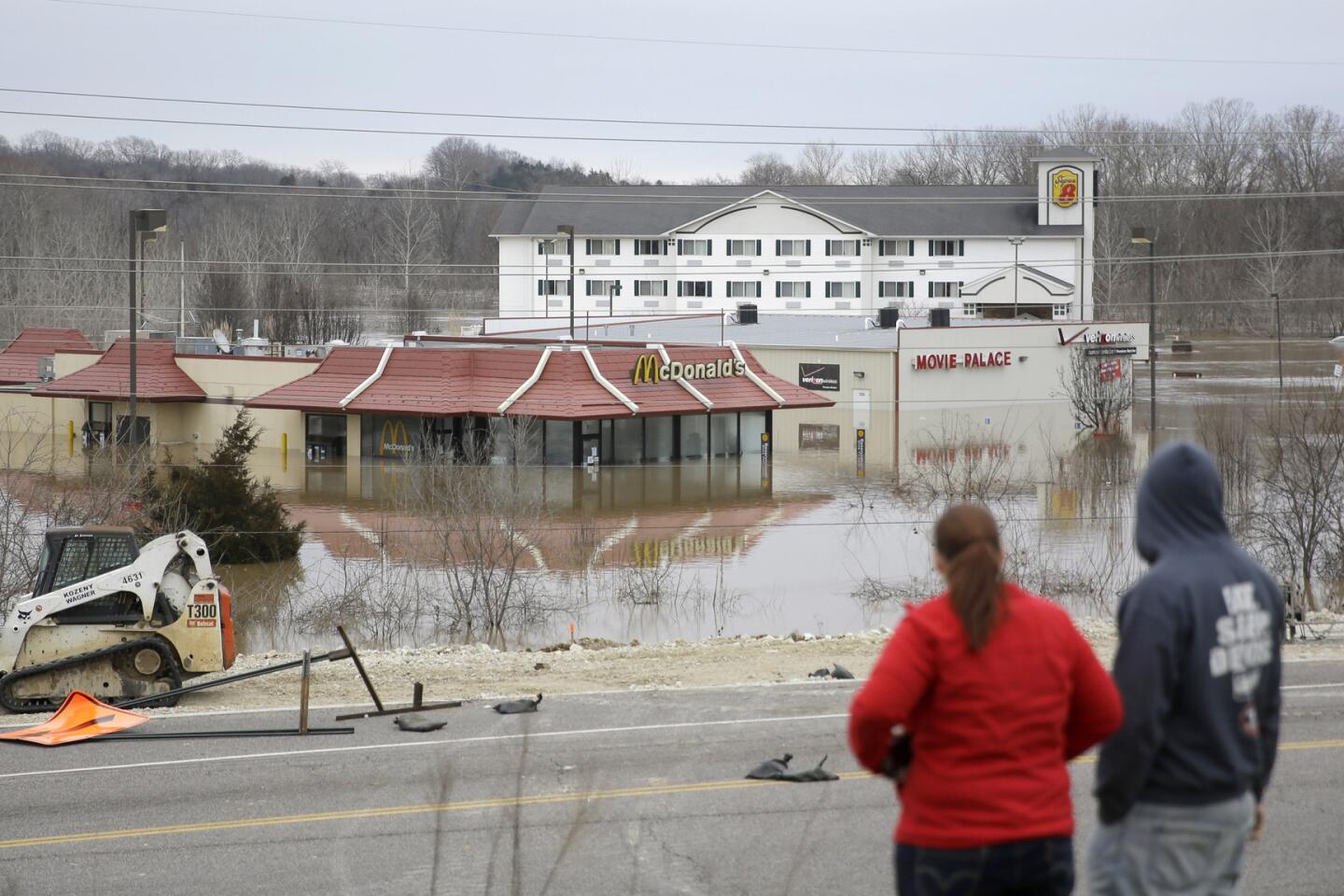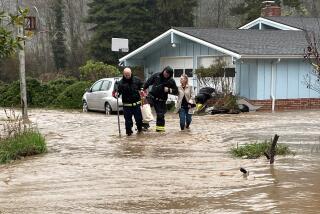Evacuees wait out historic floods still spreading through Midwest
Twelve-year-old Leviticus Hurst woke up one morning this week and looked out at his family’s Ford Taurus parked in the street.
“Mom!” Leviticus called out. “The car’s underwater!”
Floodwater had already reached the car’s floorboard — and was still rising. The Hurst family quickly stacked their couches on crates, grabbed some clothes and evacuated as the water rose. That was Monday. They moved to a friend’s one-bedroom house, which now holds four adults, two children and two dogs.
“He just wants to go home, but he can’t go home,” Cynthia Hurst, 45, said of son Leviticus as the family grabbed meals and took showers Wednesday at a Red Cross shelter in downtown Pacific, about 35 miles west of St. Louis. “I don’t know what to do.”
Unusual doesn’t begin to describe it -- it’s huge. This is a big, big, big flood for a lot of people.
— Mark Fuchs, National Weather Service hydrologist
Like hundreds of other evacuees across the rain-drenched lower Midwest, the Hursts were waiting out a historic and rare December flood that has killed at least 19 people and sent rivers sweeping out of their banks and into homes and businesses across Oklahoma, Illinois and Missouri.
“Unusual doesn’t begin to describe it — it’s huge,” said Mark Fuchs, a hydrologist at the National Weather Service’s St. Louis-area office. “This is a big, big, big flood for a lot of people.”
The floods began with warm-weather storms that brought almost a foot of rain to some areas in the lower Midwest between Saturday and Monday. It’s only the start of a winter flood-fighting effort that’s expected to eventually stretch over hundreds of miles. The U.S. Army Corps of Engineers forecasts major flood levels on the Mississippi River to eventually reach Memphis, Tenn.; Vicksburg, Miss.; and New Orleans.
In Missouri, Democratic Gov. Jay Nixon activated the National Guard on Tuesday as residents fled their homes and reports came in of motorists who died when churning floodwaters swept their vehicles off the roadways.
NEWSLETTER: Get the day’s top headlines from Times Editor Davan Maharaj >>
Hundreds of roads have been closed across Missouri, and temperatures hovered in the 30s as volunteers sandbagged in the cold on Wednesday. In Pacific, a community of 7,077, the bulging Meramec River was nearing a record high Wednesday and had submerged parts of the city’s downtown.
With floodwaters visible several blocks away, city Alderman Mike Pigg, 47, and volunteer Rita Duncan, 37, directed sandbagging efforts as pickup trucks hauled sand where it was needed.
“How much sleep have I had?” asked Pigg, his voice hoarse from organizing the town’s flood defense with Duncan since Sunday. “What day is it? Wednesday?”
By the time sandbagging ended Wednesday, Pigg couldn’t estimate how many tons of sand had been distributed. “We moved a lot of sand,” he said.
After the floodwaters crest in Pacific, which was predicted to happen Wednesday, they will gush down the Meramec to Valley Park, Mo., where hundreds of the 6,896 residents have been ordered to evacuate. Valley Park was decimated by a flood in 1982. A 3.1-mile levee now protects the lower east end of the city.
The Meramec was forecast to swell higher than 44 feet by early Thursday morning, but city officials were confident the levee would hold.
Along Valley Park’s levee, some onlookers took pictures and others gasped as they saw the power lines sticking out of the muddy brown water like Popsicle sticks.
“It’s kind of scary,” said Jake Cooper, 25, who lives about a quarter-mile away from the levee. “I hope it holds.”
After the Meramec passes through Valley Park, the floodwaters will join the Mississippi River south of St. Louis. Even before their arrival, the Mississippi has gained monstrous strength.
Historically, the median flow of water rushing through the Mississippi River in St. Louis on Dec. 30 is 107,000 cubic feet per second, according to Fuchs, the weather service hydrologist.
But on Wednesday, 780,000 cubic feet of water gushed through St. Louis every second — about 67 billion cubic feet of water a day. In St. Louis, officials are expected to see the river reach its third-highest level ever.
The Army Corps of Engineers has raised the possibility of activating some of the Mississippi River’s last-ditch flood-prevention infrastructure: The Birds Point-New Madrid Floodway, which would release waters into rural southeastern Missouri; the Bonnet Carre Spillway, which protects New Orleans; and the Morganza floodway, which helps keep the Mississippi River from changing course.
MORE: Get our best stories in your Facebook feed >>
The Birds Point-New Madrid Floodway was last activated during the flood of 2011, when the levee was dynamited to flood some Missouri farmland in order to protect Cairo, Ill., from becoming submerged.
Although officials “do not anticipate” opening the floodway again, the Army Corps said Tuesday it had began preparing for that possibility.
In Oklahoma — where Army Corps officials were strategically releasing water from reservoirs to control the amount of flooding — 29-year-old country musician Craig Strickland was still missing after disappearing on a hunting trip during the floods.
His friend Chase Morland, 22, has been found dead. Before disappearing, Morland had tweeted: “In case we don’t come back, @BackroadCRAIG and I are going right through Winter Storm Goliath to kill ducks in Oklahoma.”
He added a hashtag: “#IntoTheStorm.”
Special correspondent Witthaus reported from Pacific, Mo., and staff writer Pearce from Los Angeles.
ALSO
Another cold night expected in Southern California
11 dead after tornadoes sweep through Dallas area
California officials upbeat about snowpack, but drought outlook remains uncertain
More to Read
Start your day right
Sign up for Essential California for news, features and recommendations from the L.A. Times and beyond in your inbox six days a week.
You may occasionally receive promotional content from the Los Angeles Times.
